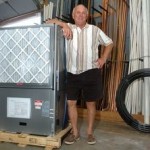This time of year, it seems that you’re covering almost everything. You’re wrapping up in hats and scarves and you’re putting frost blankets over your garden plants at night. You might even be covering a beloved boat, motorcycle, or summer convertible.
If you have an outdoor air conditioner that won’t be used during the winter months, you might be wondering if you should cover it, too. The answer is – yes!

Air conditioners don't like to be left out in the cold!
Covering your air conditioner is one of the best ways to protect your investment and keep future costs down. Here’s why:
- Covering your outdoor air conditioner provides maximum protection against debris (leaves, branches, acorns, pine needles, sand, and salt).
- A cover stops precipitation from getting into the system, then freezing and expanding. (Also, if you live near the ocean, it keeps out salty water and air.)
- An air conditioner cover minimizes the possibility of damage during storms, when tree branches or hail may fall on the unit and chip the paint or bend the fins on the grille.
- You’ll increase the efficiency of your air conditioner by keeping the condensing coil clean (good for the environment and for your wallet!)
- You’ll have less cleaning and repairing to do next spring – and your maintenance costs will be lower!
Covering your air conditioner will extend its life and reduce its operating costs. But…you need to be smart about how you cover your outdoor AC. If you cover it with plastic, you may trap moisture around the unit, creating ideal conditions for rust, mold, and mildew. This is especially a concern on those sunny winter days when the air inside the cover will heat up to be much hotter than the outside air. Also, a plastic cover can create a very cozy place for rodents and insects to spend the winter. Once they’re inside the cover, it won’t take them long to find their way into the equipment itself.
You should make sure to choose a cover made of breathable material – NOT plastic. The cover should also have appropriate ventilation to ensure that moisture doesn’t build up.
How do you choose the best cover for your air conditioner? Consult your owner’s manual, and contact us for advice. We’ll be happy to help.
Also, make sure to schedule a service appointment for the spring, before you start your unit up again. The service will include a thorough cleaning of any debris that did find its way into your unit, plus a check for any damage to the fins. We’ll also check that the pipe insulation is in good shape and that the unit is level – two simple but important things that can improve your unit’s functioning and efficiency.
P.S. If you have a window AC unit, the ideal solution is to take it out for the winter instead of covering it.
This time of year, it seems that you’re covering almost everything. You’re wrapping up in hats and scarves and you’re putting frost blankets over your garden plants at night. You might even be covering a beloved boat, motorcycle, or summer convertible.
If you have an outdoor air conditioner or heat pump unit that won’t be used during the winter months, you might be wondering if you should cover it, too.
It seems like a simple question, but in fact it generates a fair amount of controversy.
Almost everyone thinks that it’s advisable to cover outdoor AC and heat pump units rather than leaving them completely exposed to the elements. However, not everyone approves of covering the units completely.
On the one hand, putting a full cover on an outdoor air conditioner or heap pump provides maximum protection against debris (leaves, branches, sand, and salt). A cover also stops water from getting into the system and then freezing and expanding in there. Plus, a full cover minimizes the possibility of damage during storms, when tree branches or hail may fall on the unit and chip the paint or bend the fins on the grille.
On the other hand, completely covering outdoor air conditioners and heat pumps can trap moisture around the unit, creating ideal conditions for rust, mold, and mildew. This is especially a concern on those sunny winter days when the air inside the cover will heat up to be much hotter than the outside air. Also, a cover can create a very cozy place for rodents and insects to spend the winter. Once they’re inside the cover, it won’t take them long to find their way into the equipment itself.
One common way to cover air conditioners and heat pumps is simply to place a piece of plywood across the top of the unit, weighted down with cinderblocks (bricks and smaller rocks have can been reported to blow off in strong winds). This will keep out the worst of the precipitation and debris, but will still leave the unit well-ventilated. And, there will be no place for moisture or vermin to linger!
If you do opt for a full cover for your heat pump or air conditioner, make sure that it is not plastic. The cover should be made of a breathable material, and should be vented to prevent the buildup of hea
This time of year, it seems that you’re covering almost everything. You’re wrapping up in hats and scarves and you’re putting frost blankets over your garden plants at night. You might even be covering a beloved boat, motorcycle, or summer convertible.
If you have an outdoor air conditioner or heat pump unit that won’t be used during the winter months, you might be wondering if you should cover it, too.
It seems like a simple question, but in fact it generates a fair amount of controversy.
Almost everyone thinks that it’s advisable to cover outdoor AC and heat pump units rather than leaving them completely exposed to the elements. However, not everyone approves of covering the units completely.
On the one hand, putting a full cover on an outdoor air conditioner or heap pump provides maximum protection against debris (leaves, branches, sand, and salt). A cover also stops water from getting into the system and then freezing and expanding in there. Plus, a full cover minimizes the possibility of damage during storms, when tree branches or hail may fall on the unit and chip the paint or bend the fins on the grille.
On the other hand, completely covering outdoor air conditioners and heat pumps can trap moisture around the unit, creating ideal conditions for rust, mold, and mildew. This is especially a concern on those sunny winter days when the air inside the cover will heat up to be much hotter than the outside air. Also, a cover can create a very cozy place for rodents and insects to spend the winter. Once they’re inside the cover, it won’t take them long to find their way into the equipment itself.
One common way to cover air conditioners and heat pumps is simply to place a piece of plywood across the top of the unit, weighted down with cinderblocks (bricks and smaller rocks have can been reported to blow off in strong winds). This will keep out the worst of the precipitation and debris, but will still leave the unit well-ventilated. And, there will be no place for moisture or vermin to linger!
If you do opt for a full cover for your heat pump or air conditioner, make sure that it is not plastic. The cover should be made of a breathable material, and should be vented to prevent the buildup of heat and moisture.
How do you decide how best to cover your air conditioner or heat pump? Consult your owner’s manual, and call us for advice. We’ll be happy to help.
No matter how you decide to cover your heat pump or air conditioner, you should contact us to schedule a service appointment in the spring, before you start your unit up again. The service will include a thorough cleaning of any debris that did find its way into your unit, plus a check for any damage to the fins. We’ll also check that the pipe insulation is in good shape and that the unit is level – two simple but important things that can improve your unit’s functioning and efficiency.
P.S. If you have a window AC unit, the ideal solution is to take it out for the winter instead of covering it.
t and moisture.
How do you decide how best to cover your air conditioner or heat pump? Consult your owner’s manual, and call us for advice. We’ll be happy to help.
No matter how you decide to cover your heat pump or air conditioner, you should contact us to schedule a service appointment in the spring, before you start your unit up again. The service will include a thorough cleaning of any debris that did find its way into your unit, plus a check for any damage to the fins. We’ll also check that the pipe insulation is in good shape and that the unit is level – two simple but important things that can improve your unit’s functioning and efficiency.
P.S. If you have a window AC unit, the ideal solution is to take it out for the winter instead of covering it.
Continue Reading
Tags: Air Conditioning, Winterization
Posted in Air Conditioning, Winterizing | Comments Off on How to Cover Your Air Conditioner for the Winter




